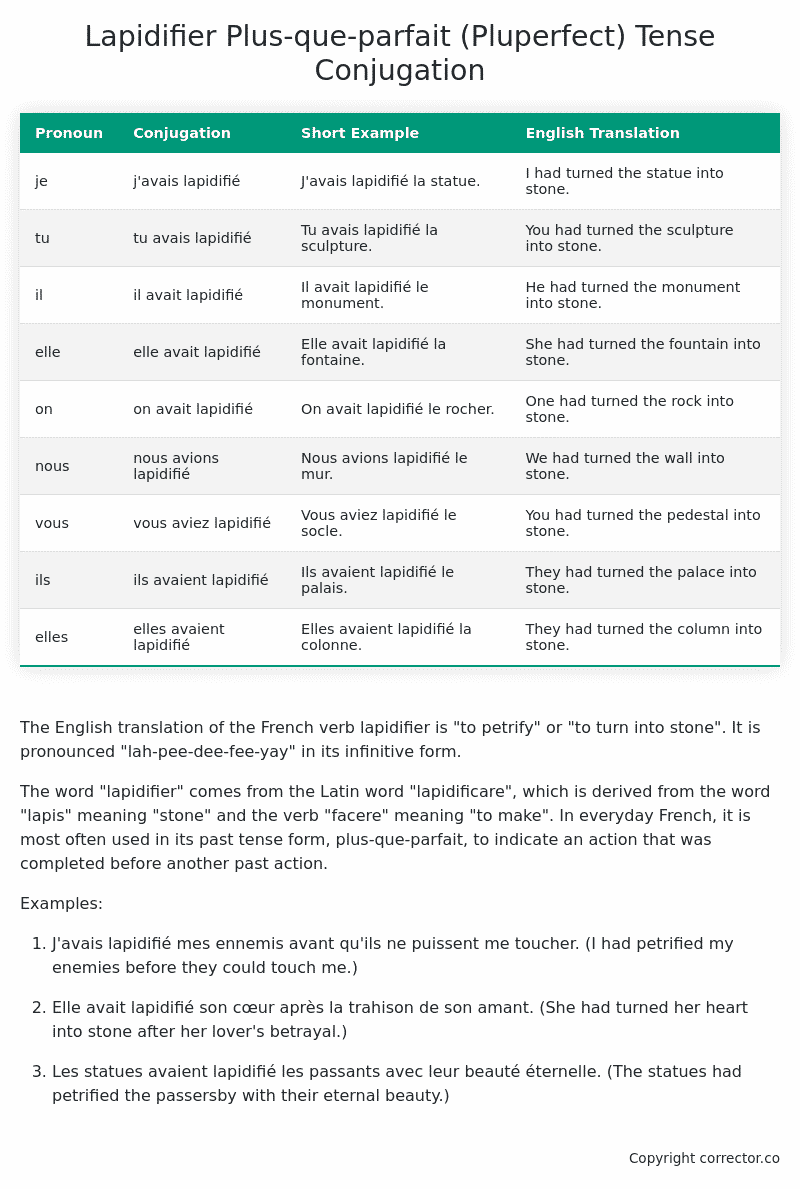Plus-que-parfait (Pluperfect) Tense Conjugation of the French Verb lapidifier
Introduction to the verb lapidifier
The English translation of the French verb lapidifier is “to petrify” or “to turn into stone”. It is pronounced “lah-pee-dee-fee-yay” in its infinitive form.
The word “lapidifier” comes from the Latin word “lapidificare”, which is derived from the word “lapis” meaning “stone” and the verb “facere” meaning “to make”. In everyday French, it is most often used in its past tense form, plus-que-parfait, to indicate an action that was completed before another past action.
Examples:
-
J’avais lapidifié mes ennemis avant qu’ils ne puissent me toucher. (I had petrified my enemies before they could touch me.)
-
Elle avait lapidifié son cœur après la trahison de son amant. (She had turned her heart into stone after her lover’s betrayal.)
-
Les statues avaient lapidifié les passants avec leur beauté éternelle. (The statues had petrified the passersby with their eternal beauty.)
Table of the Plus-que-parfait (Pluperfect) Tense Conjugation of lapidifier
| Pronoun | Conjugation | Short Example | English Translation |
|---|---|---|---|
| je | j’avais lapidifié | J’avais lapidifié la statue. | I had turned the statue into stone. |
| tu | tu avais lapidifié | Tu avais lapidifié la sculpture. | You had turned the sculpture into stone. |
| il | il avait lapidifié | Il avait lapidifié le monument. | He had turned the monument into stone. |
| elle | elle avait lapidifié | Elle avait lapidifié la fontaine. | She had turned the fountain into stone. |
| on | on avait lapidifié | On avait lapidifié le rocher. | One had turned the rock into stone. |
| nous | nous avions lapidifié | Nous avions lapidifié le mur. | We had turned the wall into stone. |
| vous | vous aviez lapidifié | Vous aviez lapidifié le socle. | You had turned the pedestal into stone. |
| ils | ils avaient lapidifié | Ils avaient lapidifié le palais. | They had turned the palace into stone. |
| elles | elles avaient lapidifié | Elles avaient lapidifié la colonne. | They had turned the column into stone. |
Other Conjugations for Lapidifier.
Le Present (Present Tense) Conjugation of the French Verb lapidifier
Imparfait (Imperfect) Tense Conjugation of the French Verb lapidifier
Passé Simple (Simple Past) Tense Conjugation of the French Verb lapidifier
Passé Composé (Present Perfect) Tense Conjugation of the French Verb lapidifier
Futur Simple (Simple Future) Tense Conjugation of the French Verb lapidifier
Futur Proche (Near Future) Tense Conjugation of the French Verb lapidifier
Plus-que-parfait (Pluperfect) Tense Conjugation of the French Verb lapidifier (this article)
Passé Antérieur (Past Anterior) Tense Conjugation of the French Verb lapidifier
Futur Antérieur (Future Anterior) Tense Conjugation of the French Verb lapidifier
Subjonctif Présent (Subjunctive Present) Tense Conjugation of the French Verb lapidifier
Subjonctif Passé (Subjunctive Past) Tense Conjugation of the French Verb lapidifier
Subjonctif Imparfait (Subjunctive Imperfect) Tense Conjugation of the French Verb lapidifier
Subjonctif Plus-que-parfait (Subjunctive Pluperfect) Tense Conjugation of the French Verb lapidifier
Conditionnel Présent (Conditional Present) Tense Conjugation of the French Verb lapidifier
Conditionnel Passé (Conditional Past) Tense Conjugation of the French Verb lapidifier
L’impératif Présent (Imperative Present) Tense Conjugation of the French Verb lapidifier
L’infinitif Présent (Infinitive Present) Tense Conjugation of the French Verb lapidifier
Struggling with French verbs or the language in general? Why not use our free French Grammar Checker – no registration required!
Get a FREE Download Study Sheet of this Conjugation 🔥
Simply right click the image below, click “save image” and get your free reference for the lapidifier Plus-que-parfait tense conjugation!

Lapidifier – About the French Plus-que-parfait (Pluperfect) Tense
Tense Formation
Common everyday usage patterns
Sequencing of past events
Background information
Hypothetical or reported speech
Interactions with other tenses
Summary
I hope you enjoyed this article on the verb lapidifier. Still in a learning mood? Check out another TOTALLY random French verb conjugation!


